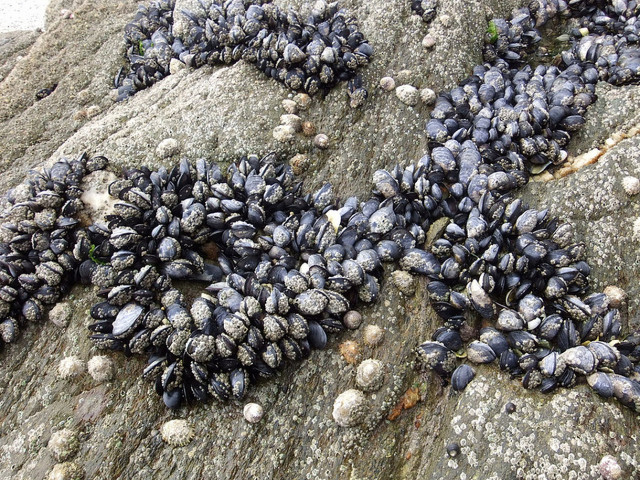Mussel Grip Secret Lies In Natural Bungee Cables Made Of Stiff And Soft Pieces

Scientists have finally unlocked the secret to a mussel’s muscles.
When they’re not being steamed in a delicious broth and served with fries, mussels can mostly be found in the intertidal zones of oceans and freshwater bodies. Though hanging out on an exposed shore usually means the mussel experiences the violent pounding and pull of waves and tides, this bivalve doesn’t clamp down for dear life like the barnacle. Instead, the mussel anchors itself to a firm surface with a group of filaments called byssal threads or byssus, also known as the “beard” that has to be yanked off the shell before you start cooking. Having a tether allows the mussel to float out and grab more nutrients, but also means it risks getting torn away by a wave.
But how can such thin threads withstand the fury of the breakwater? In a paper appearing this week in the journal Nature Communications, Massachusetts Institute of Technology scientists Zhao Qin and Markus Buehler take a close look at a mussel’s beard, which turns out to be made of some pretty strong stuff.
For the first step of their experiments, Qin and Buehler put a cage in Boston Harbor. After three weeks, they took the cage -- now covered with a collection of mussels -- out of the water. They tested the threads’ strength with a tensile machine that pulled on the mussels with controlled force. Qin and Buehler also used computer modeling to create mockups of threads with varying compositions.
The key, they found, lies not in the glue that the mussel uses to attach its beard to a surface, but in the intrinsic nature of the byssal threads themselves. About 80 percent of a byssal thread is made of stiff material, while the rest is made of softer stuff. Both materials are made using the same building block of protein, which shares properties with collagen. The soft, stretchier part of the thread attaches to the mussel, while the stiff end latches onto the rock.
This 80-20 ratio of stiff to soft material distributes the energy of an impact, allowing a mussel to roll with a wave’s punches. In fact, byssus is even stronger when facing chaotic forces; it can withstand impacts in a dynamic, sloshing environment that are up to nine times stronger than the strain of being pulled in one direction.
Knowing how the mussel’s natural bungee attachments function could help humans design similar synthetic materials. Qin and Buehler think the principle of the byssal thread could be used to make surgical sutures that can withstand pulses and irregular liquid flows. People could also model underwater cables after the mussel’s beard, and attach sensors or cameras to oceangoing vehicles without worrying the equipment could be lost at sea.
SOURCE: Qin et al. “Impact tolerance in mussel thread networks by heterogeneous material distribution.” Nature Communications published online 23 July 2013.
© Copyright IBTimes 2024. All rights reserved.




















